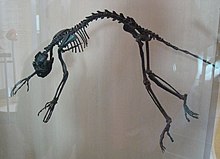Adapiformes
| Adapiformes Temporal range: Eocene - Miocene |
|
|---|---|
 |
|
| Notharctus tenebrosus | |
| Scientific classification | |
| Kingdom: | Animalia |
| Phylum: | Chordata |
| Class: | Mammalia |
| Order: | Primates |
| Suborder: | Strepsirrhini |
| Infraorder: |
†Adapiformes Hoffstetter, 1977 |
| Families | |
Adapiformes is an extinct group of early primates. Adapiforms radiated throughout much of the northern continental mass (now Europe, Asia and North America), reaching as far south as northern Africa and tropical Asia. They existed from the Eocene to the Miocene epoch. Some adapiforms looked similar to living lemurs.
Adapiforms are known from the fossil record only, and it is unclear whether they form a monophyletic or paraphyletic group. When assumed to be a clade, they are usually grouped under the "wet-nosed" taxon Strepsirrhini, which would make them more closely related to the lemurs and less so to the "dry-nosed" Haplorhini taxon that includes monkeys and apes.
In 2009, Franzen and colleagues placed the newly described genus Darwinius in the "Adapoidea group of early primates representative of early haplorhine diversification" so that, according to these authors, the adapiforms would not be within the Strepsirrhini lineage as hitherto assumed but qualify as a stem "missing link" between Strepsirrhini and Haplorrhini. However, subsequent analysis on the Darwinius fossil by Erik Seiffert and colleagues rejects this "missing link" idea, classifying Darwinius and other adapiforms within the Strepsirrhini.
Adapiforms belong to the infraorder Adapiformes, which contains a single superfamily, Adapoidea. The group also is sometimes treated as a superfamily (Adapoidea) alongside the other living strepsirrhine superfamilies, Lemuroidea (lemurs) and Lorisoidea (lorises and galagos).
...
Wikipedia
